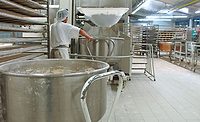Sanitation efforts will/can be very challenging as the “quiet assassin” biofilm forms in the environment of the food processing facility. Although at times the sanitation team feels like they have a “thankless job,” they are a key component of biofilm prevention.
Biofilm is composed of a complex aggregation of microorganisms that grows on a solid substrate. Biofilms affect many parts of everyday life. People experience biofilm on a regular basis: plaque that forms on your teeth, causing tooth decay, the “gunk” that clogs drains or if you walk in a stream or river, you may slip on biofilm-coated rocks.
Sanitation Controls
As for sanitation, biofilm can be a challenge to hinder the production of the quality/wholesome products you plan to deliver to the consumer.
Biofilms form when a bacterium adheres to surfaces in an aqueous environment. They begin to excrete a slimy, glue-like substance (polysaccharides) that anchor them onto surfaces. Biofilms may be present on floors, walls, pipes and drains and surfaces on equipment, including materials such as stainless steel, aluminum, nylon, Teflon, etc. Food contact surfaces such as conveyor belts, gaskets, dead spaces, as well as areas that are hard to clean may harbor biofilms. Biofilm-forming bacteria include Listeria, Salmonella, Campylobacter, Escherichia coli and Pseudomonas, which may occur as mixed cultures, but often, one species will dominate.
Prevention of biofilms may be accomplished by avoiding conditions that lead to cell attachment and selecting conditions that make the environment unfavorable for microbial growth. However, as we typically know in sanitation, this is often not possible. Proper cleaning and sanitation work best for biofilm prevention. These processes lead up to making sure your sanitarians are properly trained to “fight back” the bacterial culprits.
Let’s use Listeria as our example. Does your sanitation crew know that the size of Listeria, measured in microns, is so small compared to mold or mildew that it is like finding “a needle in a haystack?” Do they know that bugs multiply every 20 minutes—one bug at noon will multiply to over 2 million by 7 pm? Do they know that bacteria like to “hitchhike” around the building? Or have they heard the story of FAT TOM—Food, Acid (bugs grow at a pH range of 4.1–9.6), Time, Temperature, Oxygen, Moisture—these are what bacteria need for growth. Thus, the better they think like a “bug,” the more aware and prepared they will be to efficiently do their job. In addition, do they know that Listeria has the capability to “layer up” (view this as a “building block” process, one on top of the other), which implies that sanitation crews must be very disciplined with their scrubbing processes.
Controlling biofilm formation will take a dedicated team effort to avoid cell attachment and the “slimy, gooey like substance” that adds to the challenges with sanitation. The traditional way to assist with biofilm control is the following:
• Use a proper cleaner, such as a high alkaline and/or high alkaline, chlorinated cleaner
• Allow the product to have sufficient contact time on the surface (5–10 minutes)
• Agitate using mechanical/physical action
• Rinse using the proper rinse water temperature
• Select the proper sanitizer
Quaternary ammonium (quat) sanitizers are most popular, but depending on the product you produce and other concerns you may have, peracetic acid and/or chlorine dioxide can be acceptable alternatives. Today’s technology continues to change in order to adequately address biofilm removal. There are companies that supply alternative options: a two-part system that has a quat property as one part and hydrogen peroxide as the other has been proven to be successful. Chlorine dioxide is another viable alternative option. Some of these products are specifically targeted to drains, as they are often the most difficult to clean.
Conclusions
In closing, the solution to biofilm control will be “your choice.” As you have read, there are very good options available, but it all comes back to the basics: understand biofilm and the areas in which it is prone to grow. Teach and train your employees so that they are more aware of what they are looking for and why their responsibilities are so important to the process. Importantly, select the right cleaner/sanitizer program that fits your needs and expectations. In addition to using a traditional/fundamental “cleaner,” there is no substitute for the scrubbing action needed to disrupt the biofilm. However, today’s new technology certainly challenges that thought process and can provide alternative products/processes.
As we have all come to learn, there are no shortcuts to administering an effective sanitation program. It is all about making “the right choice” in taking ownership of your program. We are confident that with your knowledge and the resources available to you, the “right choice” becomes easier.
www.spartanchemical.com
Public Enemy #1: Biofilm



